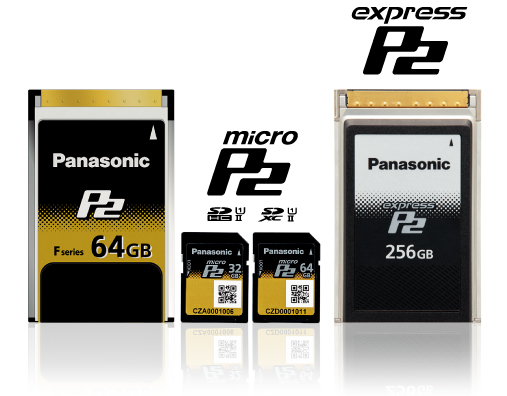Being one of the first meant they had to explain the process of downloading media to filmmakers who were used to tape or film stock. Suddenly we had data wranglers on set with laptops and RAIDs, and it was quite a change for many of us. At the time P2 cards were not only costly, but also low capacity. A 4 GB card sold for $1,700. That meant you could only record about 4 minutes of DVCPRO HD video. That's right only 4 minutes. Also, the cards themselves weren't that speedy, and the download devices were limited too. The 4 GB card had a max offload speed of 640 Mbps, put that in a USB 2.0 reader (with an effective max transfer of 280 Mbps) and you can download that card in about 2 minutes, or half real time. Shoot 4 minutes and download for 2 was not exactly elegant. There were fast PCMCIA download options, but those became extinct as computers evolved. Thankfully, Panasonic had a plan for bigger and faster cards. Below is their original timeline: 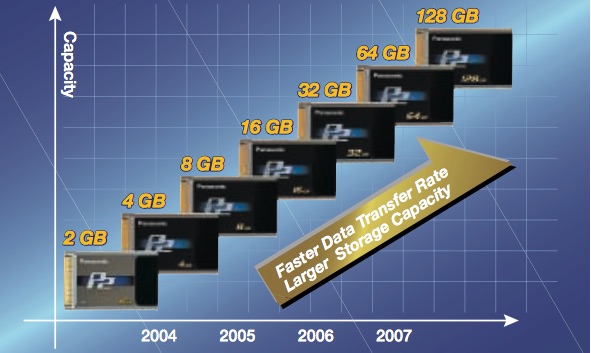
They did reach these goals through the years. The 32 & 64 GB card were released, and the E & F Series cards had a max transfer speed of 1.2 Gbps.
Then in 2012, they announced microP2 cards. These SD Card sized cards packed quite a punch with 32 GB & 64 GB sizes, and a max transfer speed of 2.0 Gbps. While they look like SD cards, if you look on the back you see an extra row of contacts.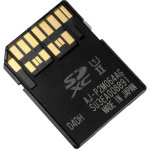 These are UHS-II SD memory cards with RAID functionality and additional error correction built inside, and they are twice as durable as a standard SD Card - so you can't break them when you sit on them. With a USB 3.0 based UHS-II SD card reader like the Panasonic AJ-MPD1G, you'll easily move footage near the card's max transfer speed of 2.0 Gbps. We tested this recently and achieved a transfer speed of about 1.6 Gbps (200 MB/s), which means you could download a full 64 GB card in just over 5 minutes (depending on your target drive speed). If you're recording in HD AVC-Intra 100 (a 422 10-bit codec) at 24p on a 64 GB microP2 card, you'd get around 106 minutes of record time. That's 23x real time - a bit of an improvement over the original cards.
These are UHS-II SD memory cards with RAID functionality and additional error correction built inside, and they are twice as durable as a standard SD Card - so you can't break them when you sit on them. With a USB 3.0 based UHS-II SD card reader like the Panasonic AJ-MPD1G, you'll easily move footage near the card's max transfer speed of 2.0 Gbps. We tested this recently and achieved a transfer speed of about 1.6 Gbps (200 MB/s), which means you could download a full 64 GB card in just over 5 minutes (depending on your target drive speed). If you're recording in HD AVC-Intra 100 (a 422 10-bit codec) at 24p on a 64 GB microP2 card, you'd get around 106 minutes of record time. That's 23x real time - a bit of an improvement over the original cards.
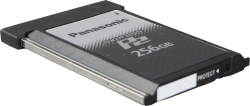 Now, 10 years after the launch of the original P2 cards, Panasonic has released their new expressP2 cards. These cards look like the original P2 cards, but you'll notice that they are a bit thicker. Right now they are shipping in one size, a hefty 256 GB, with a transfer speed of 2.4 Gbps. That's 64x bigger than a 4GB card and 3.75x faster. They retail for just about $2,000 each - pretty similar to a 4GB P2 card in 2004. These fast cards can record 4K video out of the VariCam 35 at speeds up to 120 fps. At 24p, their 4K AVC Intra 422 codec comes in at 320 Mbps, giving you 106 minutes of record time. To download these 'fat' P2 cards, you need an expressP2 card reader (AU-XPD1) that has a simple USB 3.0 connection. We tested the reader and were able to consistently get 2.4 Gbps (300 MB/s) of data transfer off the card. To achieve these speeds, our target drives were fast - the internal SSD on a Mac and Thunderbolt Pegasus R6 RAID (configured in RAID 5). With this transfer speed we could download a full 256 GB card in under 15 minutes. That's 7x real time, pretty fantastic for 4K video. If you record in HD or 2K AVC Intra 100 on the 256 expressP2 card, you'd get 430 minutes of record time and a transfer speed of 28x real time. You can also use the expressP2 drive to read old P2 cards, as well as microP2 cards with an adapter giving you the full transfer speed of those cards as well.
Now, 10 years after the launch of the original P2 cards, Panasonic has released their new expressP2 cards. These cards look like the original P2 cards, but you'll notice that they are a bit thicker. Right now they are shipping in one size, a hefty 256 GB, with a transfer speed of 2.4 Gbps. That's 64x bigger than a 4GB card and 3.75x faster. They retail for just about $2,000 each - pretty similar to a 4GB P2 card in 2004. These fast cards can record 4K video out of the VariCam 35 at speeds up to 120 fps. At 24p, their 4K AVC Intra 422 codec comes in at 320 Mbps, giving you 106 minutes of record time. To download these 'fat' P2 cards, you need an expressP2 card reader (AU-XPD1) that has a simple USB 3.0 connection. We tested the reader and were able to consistently get 2.4 Gbps (300 MB/s) of data transfer off the card. To achieve these speeds, our target drives were fast - the internal SSD on a Mac and Thunderbolt Pegasus R6 RAID (configured in RAID 5). With this transfer speed we could download a full 256 GB card in under 15 minutes. That's 7x real time, pretty fantastic for 4K video. If you record in HD or 2K AVC Intra 100 on the 256 expressP2 card, you'd get 430 minutes of record time and a transfer speed of 28x real time. You can also use the expressP2 drive to read old P2 cards, as well as microP2 cards with an adapter giving you the full transfer speed of those cards as well. 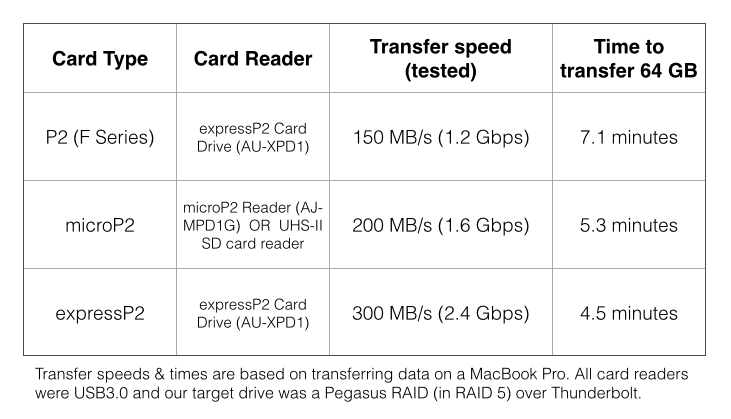
The new VariCam 35 and HS cameras card record to all types of P2 cards - it has two slots for expressP2 or regular P2 cards, as well as two slots for microP2 cards. It enables you to record to both cards at the same time, enabling an elegant 4K and HD simultaneous workflow.
P2 has come a long way over the last 10 years, and Panasonic has lead the way with solid-state media. Now they are pushing boundaries again with their new card formats. We're glad to see the evolution of P2 and can't wait to see what happens over the next 10 years.















